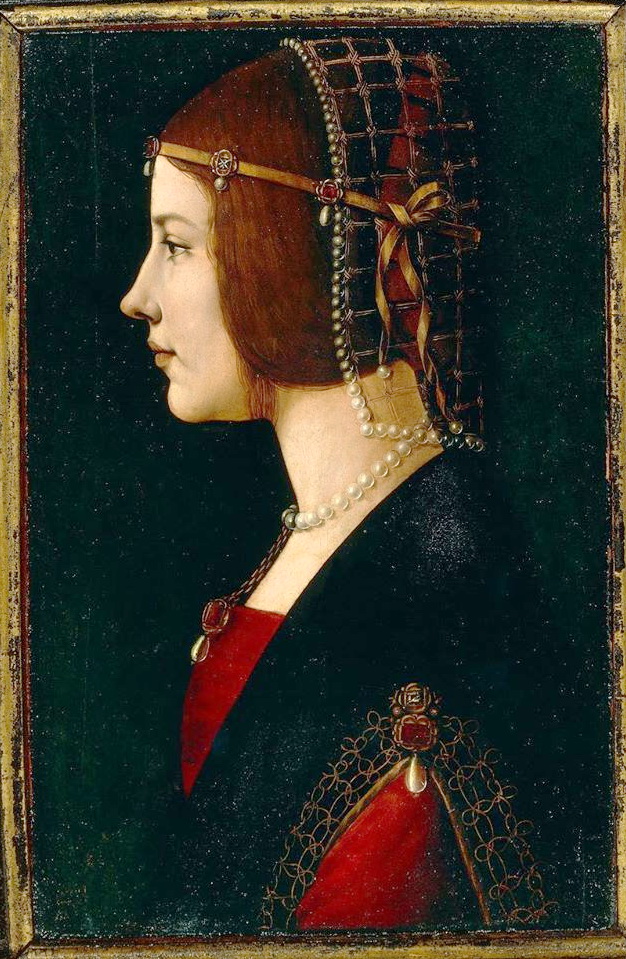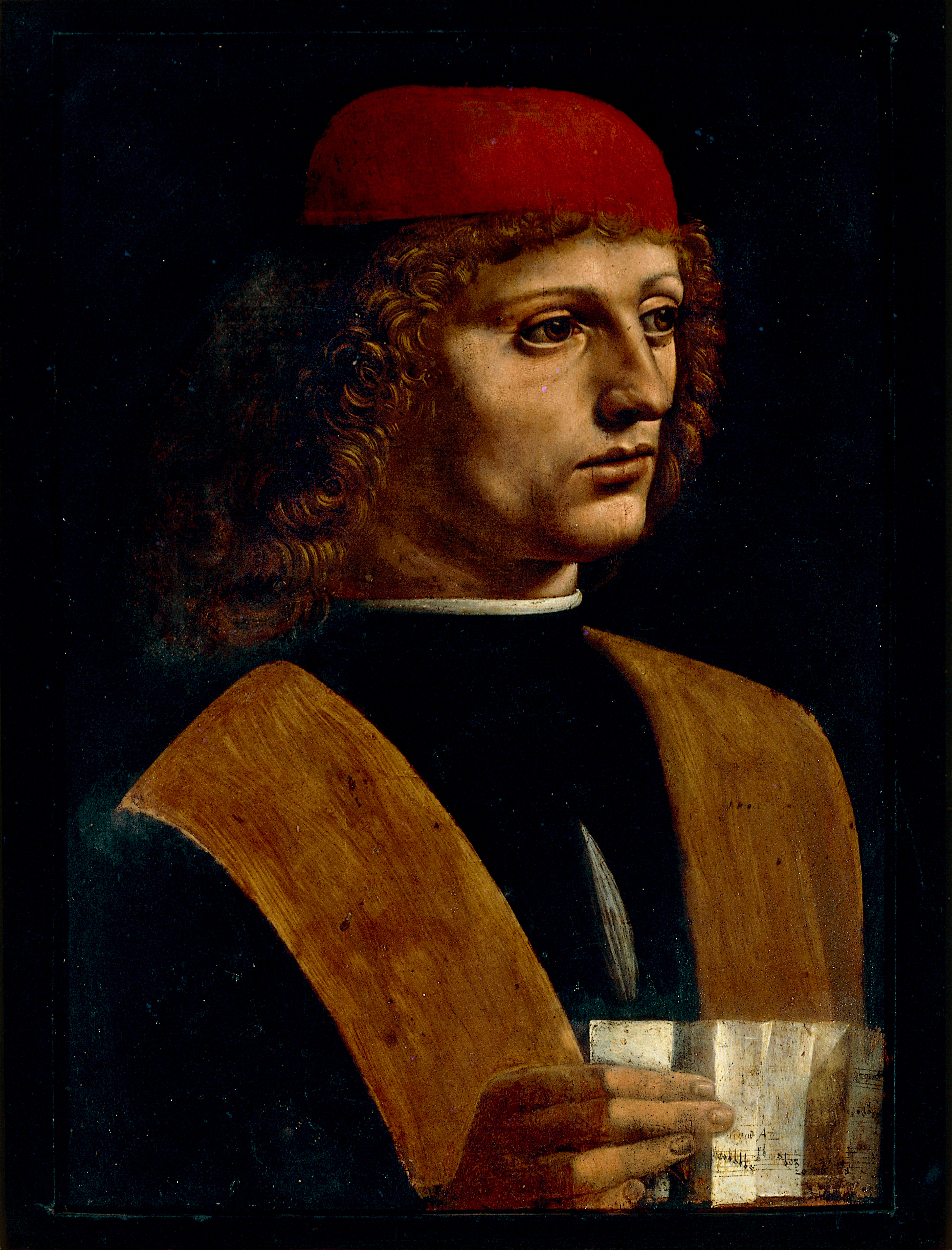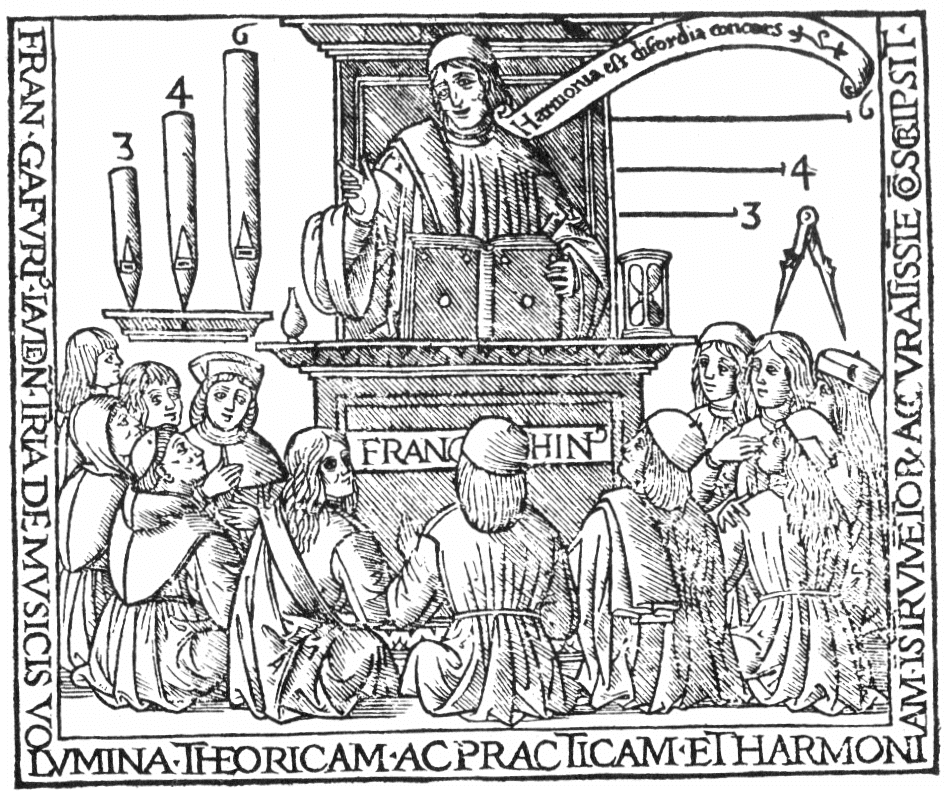|
Portrait Of A Musician
The ''Portrait of a Musician''). It is sometimes known as the ''Portrait of a Young Man'', the ''Portrait of a Man with a Sheet of Music'' or the ''Musician''., group=n is an unfinished painting widely attributed to the Italian Renaissance artist Leonardo da Vinci, dated to . Produced while Leonardo was in Milan, the work is painted in oils, and perhaps tempera, on a small panel of walnut wood. It is his only known male portrait painting, and the identity of its sitter has been closely debated among scholars. Perhaps influenced by Antonello da Messina's introduction of the Early Netherlandish style of portrait painting to Italy, the work marks a dramatic shift from the profile portraiture that predominated in 15th-century Milan. It shares many similarities with other paintings Leonardo executed there, such as the Louvre ''Virgin of the Rocks'' and the ''Lady with an Ermine'', but the ''Portrait of a Musician'' is his only panel painting remaining in the city, where it has been ... [...More Info...] [...Related Items...] OR: [Wikipedia] [Google] [Baidu] |
Italian Language
Italian (''italiano'' or ) is a Romance language of the Indo-European language family that evolved from the Vulgar Latin of the Roman Empire. Together with Sardinian, Italian is the least divergent language from Latin. Spoken by about 85 million people (2022), Italian is an official language in Italy, Switzerland (Ticino and the Grisons), San Marino, and Vatican City. It has an official minority status in western Istria (Croatia and Slovenia). Italian is also spoken by large immigrant and expatriate communities in the Americas and Australia.Ethnologue report for language code:ita (Italy) – Gordon, Raymond G., Jr. (ed.), 2005. Ethnologue: Languages of the World, Fifteenth edition. Dallas, Tex.: SIL International. Online version Itali ... [...More Info...] [...Related Items...] OR: [Wikipedia] [Google] [Baidu] |
Panel Painting
A panel painting is a painting made on a flat panel of wood, either a single piece or a number of pieces joined together. Until canvas became the more popular support medium in the 16th century, panel painting was the normal method, when not painting directly onto a wall (fresco) or on vellum (used for miniatures in illuminated manuscripts). Wood panels were also used for mounting vellum paintings. History Panel painting is very old; it was a very prestigious medium in Greece and Rome, but only very few examples of ancient panel paintings have survived. A series of 6th century BC painted tablets from Pitsa (Greece) represent the oldest surviving Greek panel paintings. Most classical Greek paintings that were famous in their day seem to have been of a size comparable to smaller modern works – perhaps up to a half-length portrait size. However, for a generation in the second quarter of the fifth-century BC there was a movement, called the "new painting" and led by Polygnotus, fo ... [...More Info...] [...Related Items...] OR: [Wikipedia] [Google] [Baidu] |
Leonardo Da Vinci - Portrait Of A Musician - Pinacoteca Ambrosiana (head Crop)
Leonardo is a masculine given name, the Italian, Spanish, and Portuguese equivalent of the English, German, and Dutch name, Leonard. People Notable people with the name include: * Leonardo da Vinci (1452–1519), Italian Renaissance scientist, inventor, engineer, sculptor, and painter Artists * Leonardo Schulz Cardoso, Brazilian singer * Emival Eterno da Costa (born 1963), Brazilian singer known as Leonardo * Leonardo de Mango (1843–1930), Italian-born Turkish painter * Leonardo DiCaprio (born 1974), American actor * Leonardo Pieraccioni (born 1965), Italian actor and director Athletes * Leonardo Araújo (born 1969), usually known as Leonardo, Brazilian World Cup-winning footballer, and former sporting director of Paris Saint Germain * Leonardo Fioravanti (born 1997), Italian surfer * Leonardo Lourenço Bastos (born 1975), Brazilian footballer * Leonardo Bittencourt, German footballer * Leonardo Bonucci (born 1987), Italian footballer * Leonardo Candi (born 1997), It ... [...More Info...] [...Related Items...] OR: [Wikipedia] [Google] [Baidu] |
Paragone
Paragone ( it, paragone, meaning ''comparison''), was a debate during the Italian Renaissance in which painting and sculpture (and to a degree, architecture) were each championed as forms of art superior and distinct to each other. While other art forms, such as architecture and poetry existed in the context of the debate, painting and sculpture were the primary focus of the debate. The debate extended beyond the fifteenth century and even influences the discussion and interpretation of artworks that may or may not have been influenced by the debate itself. A comparable question, generally posed less competitively, was known as ''ut pictura poesis'' (a quote from Horace), comparing the qualities of painting and poetry. The debate The debate began around the 15th century. Leonardo da Vinci's treatise on painting, observing the difficulty of painting and supremacy of sight, is a notable example of literature on the subject. Bendetto Varchi further sparked the conversation bet ... [...More Info...] [...Related Items...] OR: [Wikipedia] [Google] [Baidu] |
Gaspar Van Weerbeke
Gaspar van Weerbeke ( – after 1516) was a Netherlandish composer of the Renaissance. He was of the same generation as Josquin des Prez, but unique in his blending of the contemporary Italian style with the older Burgundian style of Dufay. Life He was born somewhere in the diocese of Tournai, evidently out of wedlock, and was educated at Oudenaarde. While little is known of the first two decades of his life, he probably knew or studied with Johannes Regis, and he may have studied with Johannes Ockeghem; in addition it is likely he knew Dufay at the Burgundian court of Charles the Bold, since so much of his music follows in the model of the older composer. In 1471 he went to Milan, where he joined the singers of the Sforza chapel, which included Johannes Martini, Alexander Agricola, and Loyset Compère. In 1472 and 1473 he went back north to Burgundy to find more singers for his Italian employer. Successful in his quest, he returned to Milan, and soon the Sforza chapel ha ... [...More Info...] [...Related Items...] OR: [Wikipedia] [Google] [Baidu] |
Josquin Des Prez
Josquin Lebloitte dit des Prez ( – 27 August 1521) was a composer of High Renaissance music, who is variously described as French or Franco-Flemish. Considered one of the greatest composers of the Renaissance, he was a central figure of the Franco-Flemish School and had a profound influence on the music of 16th-century Europe. Building on the work of his predecessors Guillaume Du Fay and Johannes Ockeghem, he developed a complex style of expressive—and often imitative—movement between independent voices (polyphony) which informs much of his work. He further emphasized the relationship between text and music, and departed from the early Renaissance tendency towards lengthy melismatic lines on a single syllable, preferring to use shorter, repeated motifs between voices. Josquin was a singer, and his compositions are mainly vocal. They include masses, motets and secular chansons. Josquin's biography has been continually revised by modern scholarship, and remains highly u ... [...More Info...] [...Related Items...] OR: [Wikipedia] [Google] [Baidu] |
Atalante Migliorotti
Atalante Migliorotti (1466 in Florence – 1532) was an Italian Renaissance musician, instrument maker and assistant to Leonardo da Vinci.Donald Sanders ''Music at the Gonzaga Court in Mantua'' 2012 p20 "The role of Orpheus was to be performed by Atalante Migliorotti (1466–1532) a singer, instrument maker and player of the lira da braccio, the instrument that typically represented Orpheus' lyre in Renaissance theatre. Atalante, a Florentine..." He was born of an illegitimate relationship. After being a pupil of Leonardo, who taught him music, he moved to Milan in 1482 to accompany his master. That same year, Leonardo is recorded as having painted his portrait; this is believed to be the ''Portrait of a Musician'' in the Pinacoteca di Brera, Milan. In 1491, according to the wishes of Isabella d'Este, he sang the lead role in the opera on the subject of Orpheus, presented at the carnival in Marmirolo. His skills as a lutenist and lutemaker led, in 1493, to a commission from Isabel ... [...More Info...] [...Related Items...] OR: [Wikipedia] [Google] [Baidu] |
Franchinus Gaffurius
Franchinus Gaffurius (Franchino Gaffurio; 14 January 1451 – 25 June 1522) was an Italian music theorist and composer of the Renaissance. He was an almost exact contemporary of Josquin des Prez and Leonardo da Vinci, both of whom were his personal friends. He was one of the most famous musicians in Italy in the late 15th and early 16th centuries. Life He was born in Lodi to an aristocratic family. Early in life he entered a Benedictine monastery, where he acquired his early musical training; later he became a priest. Later he lived in Mantua and Verona before settling in Milan as the ''maestro di cappella'' at the cathedral there, a position which he accepted in January 1484. During the previous decade the Sforza family, using the composer Gaspar van Weerbeke as a recruiter, had built the choir at their chapel in Milan into one of the largest and most distinguished musical ensembles in Europe: composer-singers such as Alexander Agricola, Loyset Compère and Johannes Ma ... [...More Info...] [...Related Items...] OR: [Wikipedia] [Google] [Baidu] |
Sheet Music
Sheet music is a handwritten or printed form of musical notation that uses List of musical symbols, musical symbols to indicate the pitches, rhythms, or chord (music), chords of a song or instrumental Musical composition, musical piece. Like its analogs – printed Book, books or Pamphlet, pamphlets in English, Arabic, or other languages – the medium of sheet music typically is paper (or, in earlier centuries, papyrus or parchment). However, access to musical notation since the 1980s has included the presentation of musical notation on computer screens and the development of scorewriter Computer program, computer programs that can notate a song or piece electronically, and, in some cases, "play back" the notated music using a synthesizer or virtual instrumentation, virtual instruments. The use of the term "sheet" is intended to differentiate written or printed forms of music from sound recordings (on vinyl record, compact cassette, cassette, Compact disc, CD), radio or Telev ... [...More Info...] [...Related Items...] OR: [Wikipedia] [Google] [Baidu] |
Overpainting
Overpainting is the final layers of paint, over some type of underpainting, in a system of working in layers. It can also refer to later paint added by restorers, or an artist or dealer wishing to "improve" or update an old image—a very common practice in the past. The underpainting gives a context in which the paint-strokes of the overpainting become more resonant and powerful. When properly done, overpainting does not need to completely obscure the underpainting. It is precisely the interaction of the two that gives the most interesting effects. Overpainting was used extensively in many schools of art. Some of the most spectacular results can be seen in the work of Jan van Eyck. It can be difficult to distinguish overpainting from underpainting in finished historical artworks in the absence of scientific tests. X-rays An X-ray, or, much less commonly, X-radiation, is a penetrating form of high-energy electromagnetic radiation. Most X-rays have a wavelength ranging from 1 ... [...More Info...] [...Related Items...] OR: [Wikipedia] [Google] [Baidu] |
Duchy Of Milan
The Duchy of Milan ( it, Ducato di Milano; lmo, Ducaa de Milan) was a state in northern Italy, created in 1395 by Gian Galeazzo Visconti, then the lord of Milan, and a member of the important Visconti family, which had been ruling the city since 1277. At that time, it included twenty-six towns and the wide rural area of the middle Padan Plain east of the hills of Montferrat. During much of its existence, it was wedged between Savoy to the west, Venice to the east, the Swiss Confederacy to the north, and separated from the Mediterranean by Genoa to the south. The duchy was at its largest at the beginning of the 15th century, at which time it included almost all of what is now Lombardy and parts of what are now Piedmont, Veneto, Tuscany and Emilia-Romagna. Under the House of Sforza, Milan experienced a period of great prosperity with the introduction of the silk industry, becoming one of the wealthiest states during the Renaissance. From the late 15th century, the Duchy of M ... [...More Info...] [...Related Items...] OR: [Wikipedia] [Google] [Baidu] |
Ludovico Sforza
Ludovico Maria Sforza (; 27 July 1452 – 27 May 1508), also known as Ludovico il Moro (; "the Moor"). "Arbiter of Italy", according to the expression used by Guicciardini,Opere inedite di Francesco Guicciardini etc, Storia fiorentina, dai tempi di Cosimo de' Medici a quelli del gonfaloniere Soderini, 3, 1859, p. 217 was an nobleman who ruled as from 1494 to 1499. Endowed with rare intellect and very ambitious, he managed, although fourth son, to acquire dominion over ... [...More Info...] [...Related Items...] OR: [Wikipedia] [Google] [Baidu] |


.jpg)





